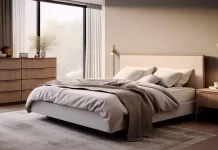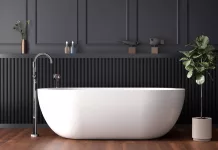
First Published: 15th December 2021, written by Olivia Doonan | Last Updated on 17th November 2022 | Reviewed and Edited by Chloe Safilo
The kitchen is the heart of the home; it acts as the central hub for most families. However, it is not always easy – there are a lot of factors to consider. The kitchen is the most high-traffic area for all family members within the home. Getting the design right is vital, although it can be daunting for a lot of people, which is why we have put together this guide. Read on for more.
The Budget
This is the first thing that you need to nail down. It is a key consideration. The cost of a new kitchen can quickly become out of control if you haven’t got a budget in mind before you start. How much can you afford to spend? Do some research to come up with a realistic budget. Think about all of the elements that you want to change and the areas where you can choose cheaper options to save some money.
The Style
After deciding on your budget, the next thing you need to think about is the style of your kitchen. There are a lot of different styles for you to choose from, and you can find inspiration online to help you decide. When deciding, you need to bear in mind the design of your home as a whole. You can mix and match styles but try to make sure that you carry design elements across to give it a more cohesive feel. It is your home at the end of the day; you need to like it!

Colour Palette
The next thing to consider is the colour palette. Again, it comes down to personal preference. There are a lot of options when it comes to adding colour to your kitchen. You can keep your cabinets neutral and opt to make a statement on the walls. Or, you could opt to keep your walls neutral and choose colourful cabinets to make more of a statement.
Painted kitchens, like the ones from Kesseler, are eye-catching and trendy. Using a service like Kessler also makes the process easier because they are designed with your family’s needs in mind. Some people like to choose colourful appliances to incorporate pops of colour throughout the room. You can be as bold as you like; jewel tones are very en vogue right now.
Storage
When designing your kitchen, you need to think about how much storage space you need. A good design provides ample space for the storage of food, all of your cookware and any other small appliances that you have. Think about your kitchen cabinetry; will it be enough? Some people choose to add an island with bar stools or a pantry to provide more storage.
If you don’t cook much, you might not have the same storage needs as someone who does. However, this might change over time, and the best kitchens are designed to grow and evolve with you.
Flooring
Kitchen floors often take far more abuse than the other rooms within your home. When choosing a floor, you need to think about its durability, appearance and how easy it is to clean. Most people tend to opt for linoleum or tiles, both of which tend to be easier to clean, but they aren’t impervious to damage.
Wood floors are also popular, but they do tend to need more maintenance than other options. Make sure to factor these considerations in when making a decision. You can make a statement with your flooring choice; for example, chequered floors have seen a resurgence in recent years.

Countertops
Your choice of countertop is important. They need to provide you with enough room to work, although this will depend entirely on your lifestyle. The material matters too, again they need to be durable and relatively easy to clean.
Laminate is the cheaper option, and there are a lot of options to choose from, but durability wise stone counters reign supreme, although they do tend to be more expensive. You can find countertops in a huge variety of designs, colours, and patterns, so it should be easy to find something that goes with your style.
Workflow
Think about your lifestyle. Your kitchen needs to be fit for purpose. Does your kitchen double as a dining room, in which case you need to consider this in the design. If the room is used exclusively for cooking and prepping food, then it would make more sense for it to be geared towards these tasks.
Don’t forget to factor in your family’s needs as well as your own. Think about the placement of your cabinets, appliances and sink. You might be limited in these aspects with the plumbing and gas outlets; however, if your budget allows, you could pay to have these moved to make your kitchen more efficient.
Lighting
The kitchen lighting is an important but often overlooked element of kitchen design. The main lighting fixtures in your kitchen can be changed relatively easily and cheaply. Consider the trends and remember that the lighting adds to the overall atmosphere of the room and provides a point of visual interest. However, task lighting can also help illuminate your workspace, so it may be worth adding some lighting under the cabinets or over the island.

Plug Sockets
Most people have a lot of appliances that need plugging in. Does your kitchen have enough sockets, and more importantly, are they located properly? Think about your and your family’s needs. Do you frequently use things like a coffee maker, kettle, slow cooker or stand mixer?
If you have to constantly unplug and swap out appliances, it can quickly become tedious. Instead, you can add in more sockets along the backsplash or create hidden spaces for them.
The Bottom Line
Getting the design of your kitchen right matters. A kitchen that isn’t fit for purpose can have a detrimental effect on your family’s day-to-day life. When your kitchen is designed around your family’s needs, it makes life easier.
Don’t forget that your kitchen can either increase or decrease the value of your home too. Keep these considerations in mind when planning your kitchen refurb.





















































